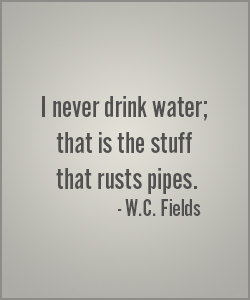Spirits 101
Spirits are alcohol beverages made from the distillation of any fermented beverage. Fermentation – the wonderful and natural process used to create all of the beer, cider, and wine that we so love is vital for the distilled spirits we love as well.
Fermentation is performed by our micro-organism friends yeast that survive and grow by consuming sugars while expelling CO2 and alcohol. The commercial and home brewer or wine maker controls the fermentation process to create a constant and desired result but fermentation occurs spontaneously. Just leave a container of fresh juice in a warm place and you will witness nature at work.
Stills – the simple but clever vessels used to create distilled spirits – do not make alcohol the can only concentrate alcohol. I make this simple but important point as I have encountered a lot of confusion on the subject.
In simple terms, we can not have Cognac without first making a wine, we cannot have Single Malt Whiskey without first making a rustic fermented beverage akin to beer.
The materials used most significantly influence the flavor of the finished distilled spirit. Most every type of grain can have their starches easily covered to sugars and nearly every fruit has a sugar content sufficient to be converted to alcohol via fermentation. Sugar itself or sugar by-products like molasses are great often used materials. We will discuss the various materials in some depth in the coming chapters.
A Brief History of Alcohol Spirits
No one really knows when distillation began (although I have heard some tell their story with great conviction). There is evidence of distilled alcohol beverage being produced in Asia around 800 BC. Several spirits known today such as Sochou (made from rice Sake) from Japan and Arrack (rice based with various sugars) from India are among these first known spirits.
It has been discovered that near 500 BC alcohol spirits were being made in clever terra-cotta stills near Taxila, now in northwest Pakistan. It appears that these stills worked by heating water to a boil in a lower chamber allowing the rising steam to pass through a bed of fermented grains. The infused vapors would then come in contact with a pot filled with old water that caused the vapors to condense and collect.
Near 500 AD the British were distilling Mead but Europe was not yet in the act. By 900 AD the Moors (moops if you prefer) were distilling for the purposes of creating a quality disinfects and for medicinal purposes but not for imbibing. The Moors were not exactly a barrel of laughs. However, the Moors alembic style stills caught the eye of Europeans namely in Spain and Sardinia and by the 1200s they were producing spirits on an annual basis.
The 1400s saw the rise of Vodka and by the 1500s many of the spirits styles we know and love were solidified including: Armagnac, Cognac, Scotch Whisky, Rum in the Americas, and others. The next greatest innovation was the introduction of the column or continuous still in the 1820s. (See distillation) By and by the principles and much of the practice of distillation has not changed since 900 AD. While the art of the distiller is vital and is what makes many spirits so iconic the technique is quite simple. However, while most everyone knows ho to operate their kitchen range, vary few are master chefs.
Distillation
Distillation is the process of concentrating alcohol. Most often this is done using heat as alcohol has a much lower boiling/vapor point than water. These rising alcohol vapors – much like steam from a boiling pot – are collected and allowed to return to liquid form. Most of the distilled alcohol produced in the world today uses heat to concentrate alcohol but this you can concentrate alcohol with sub-freezing temperatures. While alcohol has a lower boiling point than water it also has a lower freezing point than water. This method was most famously employed with the original Applejack.
The most common method of distillation is performed by employing heat in a vessel known as a still. The goal is to capture alcohol vapors as they rise. We all know that water boils at 100C while ethanol (the stuff we want to drink) boils at 78.5C. Other alcohols are also present in smaller concentrations most notably methanol. Fortunately, methanol boils a temperature well below that of ethanol. Even the most junior distiller knows to remove these harmful alcohols first before capturing the desired ethanol.
The first stills were simple, crude closed pots with a tube, known as an arm, extending from the top of the pot. This arm is used to capture rising vapor where it is cooled and collected in a separate vessel. Stills following this simple design evolved through the years and are in use today. This basic, early design known as “pot stills” or “alembic stills” where the only still type employed until the 1820s and the invention of the column or continuous still.
In the 1920s the spirits world witnessed the birth of the column still. In a short period of time there was a significant flurry of activity and innovation in regards to producing alcohol spirits. First Sir Anthony Perrier patented a continuous still in Cork, Ireland in 1822. Perrier’s work inspired Scotsman Robert Stein who made improvements to the new type of still. Irishman Aeneas Coffey, a former excise tax collector, made further and significant improvements allowing for greater efficiencies.
In the years following the receipt of his patent Coffey was taking orders for his new still. In short order there was such a demand for his new still that he closed his Dock Distillery in Dublin and dedicated all his efforts to building and installing stills. Ironically, Coffey found great resistance to his stills in Ireland while the Scots were all too eager to explore life with this new, high-efficiency still.
While many tweaks and improvements to the column still have been made over the years, the basic design and theory remains the same.
A Few Common Questions:
What does double, triple, or quadruple distillation mean?
This term is actually straightforward and descriptive as it is telling the consumer how many times the spirit was distilled. Each distillation not only further purifies the spirit but it also strips away aroma and subtle flavor agents that are naturally present. In the case of Vodka where neutrality is desired, numerous distillations are most often positive. Most Spirits are distilled at least two times with true Armagnac, which is distilled just once, being the primary exception.
Why is Whisky dark while Vodka is clear?
The answer is simply wood. Everyone has seen a room filled with barrels (or at least a picture of such a place). Color, as well as a host of flavors and aromatic contributors, is extracted from the barrels. Flavors described as being reminiscent of roasted nuts, vanilla, caramel, treacle, clove, cinnamon, nutmeg, cola, toffee, and chocolate to name a few, are all attributed to wood barrels. (Of course this does not account for the endless collection of flavors artificial and otherwise, that are added to clear Spirits.)
What does proof mean?
Proof is an all but meaningless expression of alcohol strength. It is no longer legally required on labels of Spirits but is most always found there. The origins of this measurement date to the 18th century. Alcohol was determined to be of proof when a solution of the alcohol with water could be poured on a pinch of gunpowder and the wet powder could still ignite. Further than being irrelevant today, proof is calculated differently in the US and the UK, which of course creates much confusion. The US method of calculating proof is to simply double the Spirit’s alcohol by volume (ABV) while the UK system calculates on a ratio of 7:4. A Spirit with an ABV of 40% would have a US proof of 80, whereas in the UK, it would have a calculated proof of 70.



